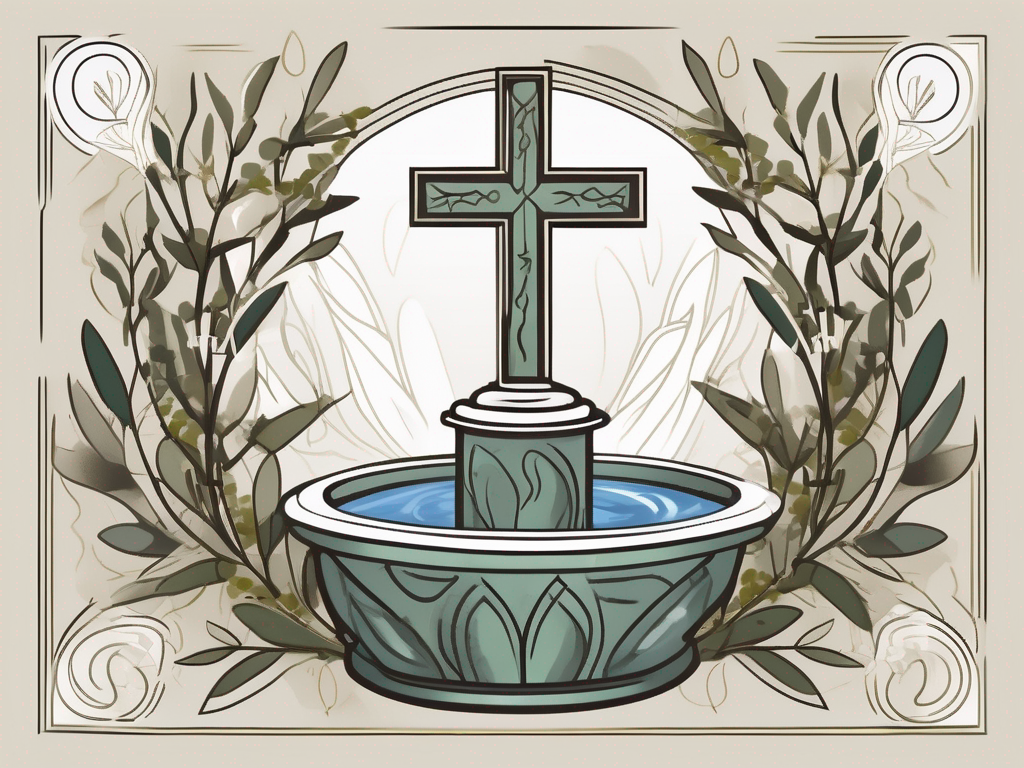Baptism is a significant practice in Christianity that holds deep spiritual meaning for believers. It is a ritual that symbolizes initiation into the Christian faith and serves as a visible sign of one’s commitment to following Jesus Christ. In this article, we will explore the concept of baptism, its various forms, its role in Christian life, the baptism ceremony itself, as well as some of the controversies and debates surrounding it.
Understanding the Concept of Baptism
Baptism, at its core, is a religious ceremony that involves the use of water as a symbol of purification, renewal, and rebirth. It is viewed as a sacrament by many Christian denominations and is considered a vital step on the path to salvation.
When we delve deeper into the concept of baptism, we discover its rich history and significance. It is not merely a ritualistic act but holds profound spiritual meaning for believers.
The Biblical Origin of Baptism
The practice of baptism finds its roots in the Bible. In the New Testament, we see Jesus himself being baptized by John the Baptist, marking the beginning of his public ministry. This event holds great significance, as it not only demonstrated Jesus’ submission to the will of God but also served as an example for his followers.
As we reflect on this biblical origin, we can appreciate the profound impact that Jesus’ baptism had on the early Christian community. It became a fundamental practice, symbolizing one’s commitment to follow Jesus and live according to his teachings.
The Symbolism of Water in Baptism
Water plays a central role in baptism, symbolizing purification and spiritual cleansing. Just as water washes away physical impurities, baptism represents the washing away of sin and the start of a new life in Christ. It is a powerful symbol of forgiveness, redemption, and new beginnings.
When an individual undergoes baptism, they are immersed in water or have water poured over them, signifying their desire to be cleansed from their past sins and to be born again in the faith. The act of baptism is a visible representation of an inward transformation, a turning away from a life of sin and a commitment to live in accordance with God’s will.
Moreover, the symbolism of water in baptism extends beyond the act itself. Water is a life-giving element, essential for our physical existence. In the same way, baptism represents the spiritual nourishment and sustenance that believers receive through their faith in Christ. It is through baptism that individuals become part of the larger body of Christ, the Church, and are united with fellow believers in their journey of faith.
As we contemplate the symbolism of water in baptism, we are reminded of the profound grace and mercy of God. Through this sacrament, believers are reminded of God’s unconditional love and his desire to reconcile humanity to himself. Baptism serves as a tangible reminder of God’s saving work and our response to his invitation to be part of his kingdom.
Different Forms of Baptism in Christianity
While the core concept of baptism remains the same, different Christian denominations may practice it in various ways. Let’s explore two prominent forms of baptism in Christianity.
Infant Baptism
Infant baptism, also known as pediatric baptism, involves the baptism of infants or young children. This practice is prevalent in some Christian traditions, such as the Roman Catholic Church and the Eastern Orthodox Church. Advocates argue that baptism at an early age welcomes children into the faith, symbolizes God’s grace, and invites the community to nurture them spiritually.
Infant baptism has a rich historical background. It can be traced back to the early days of Christianity when the practice of baptizing infants was already established. The belief behind this form of baptism is that it cleanses the child from original sin inherited from Adam and Eve. It is seen as a way to initiate the child into the Christian community and provide them with spiritual protection from an early age.
Throughout history, there have been debates and discussions surrounding infant baptism. Some argue that infants cannot fully comprehend the significance of baptism and that it should be reserved for individuals who can make a personal decision to follow Jesus Christ. However, proponents of infant baptism believe that it is an act of faith on behalf of the child, with the parents and the community taking responsibility for their spiritual upbringing.
Believer’s Baptism
Believer’s baptism, often referred to as adult baptism or believer’s baptism by immersion, is a practice followed by many Protestant denominations. It involves baptizing individuals who have reached an age of understanding and made a personal decision to follow Jesus Christ. Believer’s baptism emphasizes the importance of personal faith and conscious choice.
This form of baptism is rooted in the belief that baptism is a public declaration of one’s faith and commitment to Jesus Christ. It is seen as a symbolic act of dying to one’s old self and being raised to a new life in Christ. The act of immersion in water represents the washing away of sins and the emergence of a new person in Christ.
Believer’s baptism holds great significance for those who practice it. It is often seen as a powerful and transformative experience, marking a turning point in a person’s spiritual journey. The decision to be baptized as a believer is considered a personal and voluntary act, demonstrating a deep commitment to following Jesus Christ.
While infant baptism and believer’s baptism are two distinct forms of baptism in Christianity, both carry deep spiritual meaning and are practiced with reverence and faith. The choice of which form to practice often depends on the individual’s religious tradition and personal beliefs.
The Role of Baptism in Christian Life
Baptism holds great significance in the Christian faith and plays multiple roles in the life of a believer. It is a sacred act that symbolizes various aspects of the Christian journey and holds deep spiritual meaning.
Baptism as Initiation into the Christian Community
Baptism marks the entry into the Christian community, welcoming individuals into the church family. It is a momentous occasion where believers publicly declare their faith in Jesus Christ and their commitment to follow Him. Through baptism, individuals become part of a larger body of believers, united in their shared faith and purpose.
As new members are baptized, the church community rejoices and celebrates their decision to embark on a life of faith. It is a time of joy and fellowship, as the church family embraces and supports those who have chosen to walk the path of discipleship.
Furthermore, baptism symbolizes unity and a shared identity in Christ, connecting believers from diverse backgrounds and cultures. It serves as a reminder that, regardless of our differences, we are all one in Christ, bound together by our faith and love for Him.
The Spiritual Significance of Baptism
From a spiritual perspective, baptism represents the believer’s identification with the death, burial, and resurrection of Jesus Christ. Just as Jesus died and was buried, baptism signifies the believer’s willingness to die to their old self and be buried with Christ.
As the believer is immersed in water, they symbolically participate in the burial of Jesus. This act represents the washing away of their sins and the cleansing of their soul, as they are forgiven and made new in Christ.
Moreover, baptism is a powerful symbol of the believer’s union with Christ and their commitment to live a new life characterized by faith and obedience. It signifies their desire to follow in the footsteps of Jesus, to be transformed by His love, and to walk in righteousness.
Through baptism, the believer publicly declares their faith in Jesus and their intention to live a life that honors and glorifies Him. It is a visible testimony of their personal relationship with Christ and their dedication to live according to His teachings.
Furthermore, baptism is not just a one-time event but an ongoing journey of faith. It serves as a reminder to continually seek God’s guidance, to grow in spiritual maturity, and to live a life that reflects the love and grace of Jesus.
In conclusion, baptism is a significant and meaningful practice in the Christian faith. It serves as a gateway into the Christian community, symbolizing unity and shared identity. It also holds deep spiritual significance, representing the believer’s identification with Christ’s death, burial, and resurrection, and their commitment to live a new life in Him. Baptism is a public declaration of faith and a lifelong journey of discipleship, reminding believers of their call to follow Jesus and to be transformed by His love.
The Baptism Ceremony: A Step-by-Step Guide
The baptism ceremony typically follows a structured process, involving various rituals and solemn moments. Let’s explore the key elements of a baptism ceremony.
Pre-Baptism Rituals
Before the actual baptism takes place, there are often preparatory rituals involved. These may include prayers, readings from the Bible, and exhortations to the candidate and their family.
As the anticipation builds, the atmosphere in the church becomes filled with a sense of reverence and excitement. The congregation gathers, eagerly awaiting the start of the ceremony. The priest, dressed in his white robes, stands at the front of the church, ready to guide the candidate through this important milestone in their spiritual journey.
The sound of hymns fills the air, as the organist plays a melodious tune that resonates with the hearts of those present. The lyrics of the hymns are carefully chosen, reflecting the themes of redemption, faith, and new beginnings.
The priest begins the ceremony by leading the congregation in a prayer, invoking the presence of the Holy Spirit. The words spoken are filled with hope and blessings, setting the tone for the rest of the ceremony.
The Baptismal Vows
During the ceremony, the person being baptized usually makes a series of vows. These vows may include renouncing sin, professing faith in Jesus Christ, and committing to live according to Christian principles. The candidate may also have sponsors or godparents who stand alongside, pledging to support and guide them in their spiritual journey.
As the candidate steps forward, their heart filled with a mix of nervousness and excitement, they are greeted by the warm smiles of their sponsors. These individuals have played a significant role in the candidate’s life, providing guidance, love, and support throughout their spiritual journey.
The candidate, standing before the congregation, takes a deep breath and begins to recite the baptismal vows. Each word is spoken with conviction and sincerity, as they publicly declare their commitment to their faith and their desire to live a life that reflects the teachings of Jesus Christ.
The sponsors, standing beside the candidate, place their hands on their shoulders, symbolizing their role as mentors and guides. With their presence, they offer reassurance and encouragement, reminding the candidate that they are not alone in their journey.
As the vows are spoken, the congregation listens intently, their hearts filled with joy and admiration for the candidate’s courage and dedication. The words spoken during this sacred moment echo throughout the church, resonating with the souls of all those present.
After the vows are completed, the priest offers a prayer of blessing, asking for God’s grace and guidance to be with the candidate as they embark on this new chapter of their spiritual life. The congregation joins in, their voices blending together in a chorus of support and love.
The baptism ceremony is a beautiful and significant event in the life of a Christian. It is a moment of rebirth, symbolizing the washing away of sin and the beginning of a new life in Christ. As the ceremony continues, the candidate is led to the baptismal font, where the sacrament of baptism will be administered.
Controversies and Debates Around Baptism
As with many religious practices, baptism is not without its controversies and debates. Let’s explore a couple of the key areas of contention.
Baptism and Salvation: An Ongoing Debate
One of the ongoing debates surrounding baptism revolves around its connection to salvation. While some Christian traditions view baptism as necessary for salvation, others emphasize that salvation comes through faith alone. These differences in interpretation have led to considerable theological discussions and disagreements.
The Dispute Over Infant Baptism and Believer’s Baptism
The practice of infant baptism versus believer’s baptism has been a topic of debate among Christian denominations for centuries. While some emphasize the importance of baptizing infants as a means of God’s grace, others argue that the act should be reserved for individuals who can make a personal choice to follow Christ.
Conclusion
Baptism is a foundational practice in Christianity, representing the believer’s commitment to Christ and their incorporation into the Christian community. While there are different forms of baptism and varying interpretations, its spiritual significance remains a unifying element for Christians worldwide. Ultimately, baptism serves as a visible reminder of the believer’s identity as a follower of Jesus Christ, symbolizing their participation in the death, burial, and resurrection of their Savior.












